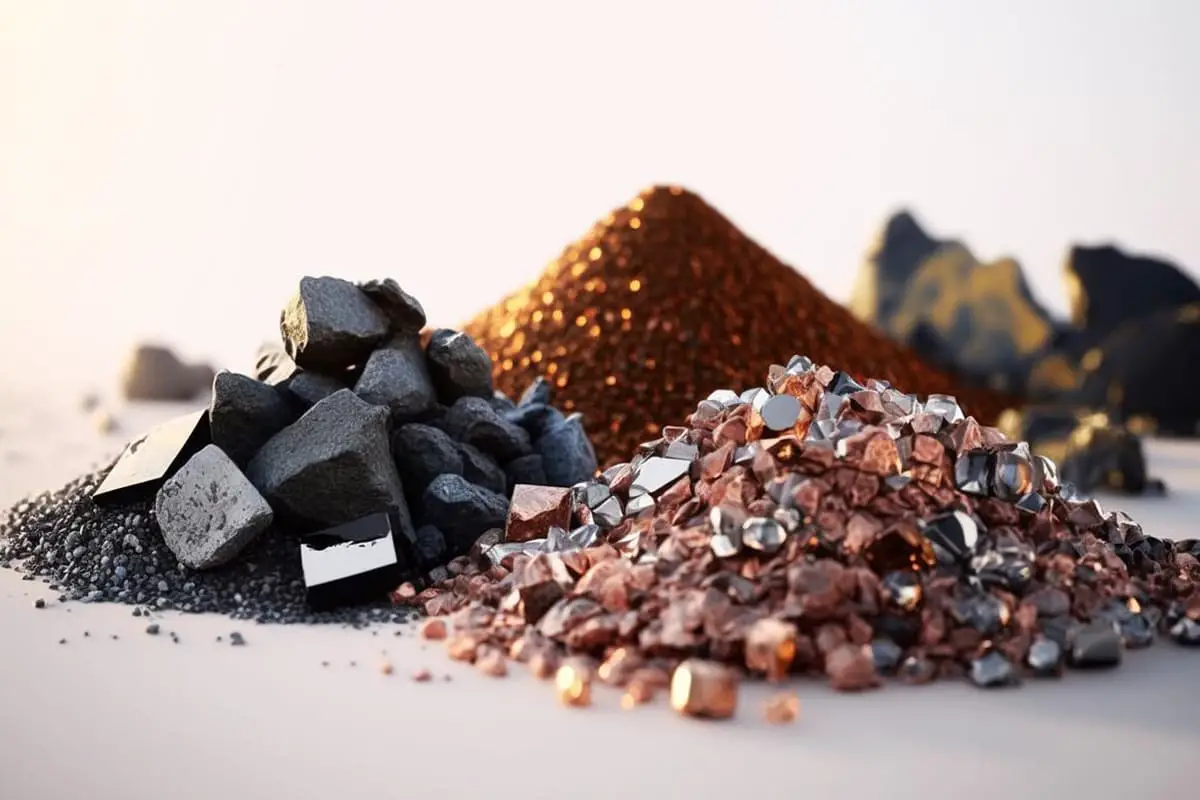
Metals are categorized into ferrous and non-ferrous types, each with unique properties and uses. This article explores the characteristics, applications, and fascinating facts about these metals, from common iron to rare earth elements. By the end, you’ll understand how different metals shape our daily lives and technological advancements. Ready to uncover the world of metals and their hidden secrets?


Ferrous metal mainly refers to iron and its alloys, such as steel, pig iron, iron alloys, and cast iron. It’s also been called “black metal”.
The names “ferrous metal” and “non-ferrous metal” can often lead to misunderstandings, as people may assume that ferrous metal is always black.
However, there are actually three types of ferrous metal: iron, manganese, and chromium, none of which are actually black.
Pure iron is silver-white, chromium is silver-white, and manganese is gray-white.
Because the surface of iron often rusts, it is covered with a mixture of black ferric oxide and brown iron oxide, which appears black. This is why people call it “ferrous metal.”
The term “ferrous metallurgy industry” mainly refers to the steel industry because the most common alloys for steel are manganese steel and chrome steel, which is why people also consider manganese and chromium as “ferrous metals.
Apart from iron, manganese, and chromium, all other metals are considered non-ferrous metals.
Non-ferrous metals, also known as colored metals in a narrow sense, refer to all metals except iron, manganese, and chromium. In a broad sense, colored metals also include colored alloys.
Non-ferrous alloys are alloys composed of one colored metal as the matrix (usually more than 50%) and one or more other elements.
Colored metals usually refer to all metals except iron (sometimes also manganese and chromium) and iron-based alloys.
Non-ferrous metals can be divided into heavy metals (such as copper, lead, zinc), light metals (such as aluminum, magnesium), precious metals (such as gold, silver, platinum), and rare metals (such as tungsten, molybdenum, germanium, lithium, lanthanum, uranium), which include a total of 64 types: aluminum, magnesium, potassium, sodium, calcium, strontium, barium, copper, lead, zinc, tin, cobalt, nickel, antimony, mercury, cadmium, bismuth, gold, silver, platinum, ruthenium, rhodium, palladium, osmium, iridium, beryllium, lithium, rubidium, cesium, titanium, zirconium, hafnium, vanadium, niobium, tantalum, tungsten, molybdenum, gallium, indium, thallium, germanium, rhenium, lanthanum, cerium, praseodymium, neodymium, samarium, europium, gadolinium, terbium, dysprosium, holmium, erbium, thulium, ytterbium, lutetium, scandium, yttrium, and thorium.
The strength and hardness of non-ferrous alloys are generally higher than those of pure metals.
They also have higher electrical resistance and lower temperature coefficient of resistance, and possess good comprehensive mechanical properties.
Common non-ferrous alloys include aluminum alloys, copper alloys, magnesium alloys, nickel alloys, tin alloys, tantalum alloys, titanium alloys, zinc alloys, molybdenum alloys, and zirconium alloys.
In practical applications, colored metals are usually classified into five categories:
The term typically refers to a group of metals that are plentiful and relatively inexpensive in the Earth’s crust, such as iron, aluminum, copper, zinc, etc.
Rare metals are metals with a low abundance and scattered distribution in the Earth’s crust, or metals that are difficult to extract from raw materials, such as lithium, beryllium, titanium, vanadium, germanium, niobium, molybdenum, cesium, lanthanum, tungsten, radium, and others.
They can be divided into different categories based on their physical and chemical properties as well as their production methods:
Rare metals are mainly used to produce special steels, superhard alloys, and high-temperature-resistant alloys, and are widely used in industries such as electrical, chemical, ceramic, atomic energy, and rocket technology.
The names of rare metals have a certain relativity, and as people’s research on rare metals expands, new sources and extraction methods are discovered, and their application scope expands, the boundary between rare metals and other metals will gradually disappear.
Some rare metals have a higher abundance in the earth’s crust than copper, mercury, cadmium, and other metals.
Some rare metals are similar in physical and chemical properties and are not easily separated into single metals. In the past, they were rarely produced and used, hence the name rare metals.
The term “rare elements” existed in the 19th century, and in the 1920s, it was renamed “rare metals.” Rare metal development is relatively late, so it is sometimes called “new metals.”
Since World War II, with the development of new technologies and the increase in demand, research and application of rare metals have rapidly developed, and new metallurgical processes continue to emerge, leading to an increase in their production.
Rare metals are no longer rare. The metals included in rare metals are also changing.
For example, titanium is increasingly used in modern technology and its production has increased, so it is sometimes classified as a light metal.
Metals with a density of less than 5000 kg/m3 are called light metals, also known as light non-ferrous metals. There are seven metals in total, including aluminum (Al), magnesium (Mg), calcium (Ca), strontium (Sr), barium (Ba), potassium (K), and sodium (Na).
Rare metals with similarly low density, such as beryllium, lithium, rubidium, and cesium, are generally classified as rare light metals.
Calcium, strontium, magnesium, and barium in light metals are collectively known as alkaline earth metals, while potassium and sodium are alkali metals.
Alkaline earth metals refer to the heavier elements in group II A of the periodic table, while alkali metals refer to all elements in group I A, including lithium, rubidium, cesium, and francium, in addition to potassium and sodium.
Aluminum, magnesium, and their alloys have many excellent physical and chemical properties and are important commonly used nonferrous metals.
Alkaline earth metals calcium, strontium, barium, and alkali metals sodium and potassium are usually used in the form of compounds in the chemical and other industries.
In addition, light metals have active chemical properties and are strong reducing agents, which are important in metallurgical industries.
Heavy metals refer to metals with a density greater than 4.5 g/cm3, including gold, silver, copper, iron, mercury, lead, cadmium, and so on.
Accumulation of heavy metals in the human body to a certain extent can cause chronic poisoning.
In terms of environmental pollution, heavy metals mainly refer to bio-toxic heavy elements such as mercury, cadmium, lead, chromium, and arsenic-like metals.
Heavy metals are very difficult to be biodegraded, but they can be enriched thousands of times in the food chain by biomagnification and finally enter the human body.
Heavy metals in the human body can strongly interact with proteins and enzymes, causing them to lose their activity, and may also accumulate in certain organs of the human body, causing chronic poisoning.
Precious metals mainly refer to eight metal elements: gold, silver, and the platinum group metals (ruthenium, rhodium, palladium, osmium, iridium, and platinum).
These metals mostly have beautiful colors and strong chemical stability, and are generally not easily reactive with other chemicals under normal conditions.
The cost of this metal is higher compared to other common metals, and its availability in the Earth’s crust is low.
This scarcity is also reflected in the Clarke value, which indicates the average concentration of chemical elements in the Earth’s crust.
Purifying this metal is a challenging task, similar to refining gold, silver, and metals belonging to the platinum group.
Amphoteric elements, also known as metalloid elements or semi-metal elements, are elements that exhibit some chemical properties of both metals and nonmetals, such as boron, silicon, germanium, arsenic, antimony, selenium, and tellurium.
Their oxides and hydroxides are often amphoteric. While they generally appear to have metallic properties, their chemical properties show characteristics of both metals and nonmetals.
Their oxides are amphoteric, meaning they dissolve in both acids and bases.
Metalloids have a relatively large number of empty electron orbitals in their electronic structure, making them highly reactive and easily able to form organometallic compounds with organic molecules.
Rare metals are metals with relatively low abundance and scattered distribution in the earth’s crust, or metals that are difficult to extract from raw materials, such as lithium, beryllium, titanium, vanadium, germanium, niobium, molybdenum, cesium, lanthanum, tungsten, and radium.
They can be classified according to their physical and chemical properties and production methods:
Rare metals are mainly used to manufacture special steel, super hard alloys, and high temperature resistant alloys in the electrical, chemical, ceramic, nuclear, and rocket industries.
The names of rare metals are relative, and with the extensive research on rare metals, the discovery of new sources and new refining methods, and the expansion of their application range, the boundaries between rare metals and other metals will gradually disappear, as some rare metals have higher abundance in the earth’s crust than copper, mercury, cadmium and other metals.
Some rare metals have similar physical and chemical properties and are not easily separated into single metals.
In the past, they were rarely produced and used, hence the name “rare metals.”
The term “rare elements” was coined in the 19th century, and in the 1920s, it was renamed “rare metals.”
Rare metal development started relatively late, so they are sometimes also called “new metals.”
Since World War II, with the development of new technologies and the increase in demand, the research and application of rare metals have rapidly developed, and new metallurgical processes have emerged, and the production of these metals has gradually increased.
Rare metals are no longer rare. The metals included in rare metals are also changing.
For example, titanium is increasingly widely used in modern technology, with an increasing production, so it is sometimes classified as a light metal.
Metal List Table
| Nonferrous Metals | copper, aluminum, lead, zinc, tin, nickel, magnesium, antimony, cobalt, mercury |
| Ferrous metal | iron, manganese and chromium |
| Noble metal | gold, silver, platinum, palladium, ruthenium, rhodium, iridium, osmium |
| Light nonferrous metal | aluminum, magnesium, sodium, potassium, calcium, strontium, barium |
| Heavy nonferrous metal | copper, nickel, lead, zinc, cobalt, tin, antimony, mercury, cadmium, bismuth |
| Rare refractory metal | zirconium, molybdenum, vanadium, hafnium |
| Rare light metal | lithium, rubidium, beryllium, cesium, titanium |
| Scattered metal | gallium, indium, thallium, germanium |
| Scattered radioactive metal | radium, uranium, plutonium, francium, polonium, thorium |
| Rare earth metal | lanthanum, cerium, praseodymium, neodymium, promethium, samarium, europium, gadolinium, terbium, dysprosium, holmium, erbium, thulium, ytterbium, lutetium, scandium and yttrium |
| Semimetal | silicon, selenium, tellurium, arsenic and boron |








